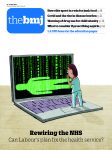
Leng review offers “pragmatic solution” in attempt to heal rift between doctors and PAs
The roles of physician associate (PA) and anaesthesia associate (AA) should not be abolished but be renamed “physician assistants” and “physician assistants in anaesthesia,” Gillian Leng’s independent review has recommended.1
Leng acknowledged that her “pragmatic” solution “won’t be universally popular.” She said that she found “no convincing reasons” to abolish the roles of PAs and AAs but that changes were needed to embed the roles into the NHS workforce effectively.
In autumn 2024 the government commissioned Leng, president of the Royal Society of Medicine and former chief executive of the National Institute for Health and Care Excellence, to head a rapid review into the safety and scope of the roles of PAs and AAs.2 This followed growing anger in the medical profession about the way PAs were being deployed and regulated.
Leng’s 18 recommendations, based on the “best available evidence,” aim to represent a “pragmatic, sensible way forward that will provide clarity and enable effective change” (box 1). She emphasised that her report must be an opportunity “to reset the hostility” in the debate and stimulate effective collaboration for the future.
Box 1
Leng’s key recommendations
-
PAs should not see undifferentiated patients except within clearly defined national clinical protocols
-
Newly qualified PAs should gain at least two years’ experience in secondary care before taking a role in primary care or a mental health trust
-
A named doctor should take overall responsibility for each PA as their formal line manager
-
Standardised measures, including clothing, lanyards, badges, and staff information, should be used to distinguish PAs from doctors
-
PAs should have the opportunity for ongoing training and development within a formal certification and credentialling programme.
-
Establish a permanent faculty to provide provisional leadership, with standards for training set by relevant medical royal colleges
-
GMC requirements for regulation and reaccreditation of PAs and AAs within Good Medical Practice should be set out separately from those for doctors
Research on safety limited and low quality
The safety of patients when PAs and AAs are working in the NHS remains one of the most controversial areas. In April the BMA published a dossier of what it described as “shocking” safety incidents involving PAs and AAs.3 Philip Banfield, then BMA chair of council, described the number of these accounts as “hair raising.”
Leng said in her report that she had gathered as much evidence as possible on the safety and effectiveness of PAs and AAs. This included a systematic review of research, an analysis of NHS trust “never events” by professional groups, and references in NHS GIRFT (Getting it Right First Time) reviews. The Care Quality Commission also analysed mentions of PAs or AAs in coroners’ reports, such as regulation 28 reports (to prevent future deaths), whistleblower files, and the Learn from Patient Safety Events system. The review also surveyed 8558 frontline staff (PAs, AAs, and healthcare professionals who work with them) and carried out patient focus groups and visits to hospital trusts and general practices.
Leng concluded that research on the safety and effectiveness of PAs and AAs was limited, generally of low quality, and either inconclusive or giving a mixed picture. She said that “significant gaps in our knowledge remain” but that, given the urgency of current workforce challenges, now was not the time to defer to the wisdom of future research.
In primary care, although the research on safety of physician associates was limited, the evidence did not provide a compelling case either that PAs were safe or unsafe, the review said. Studies on effectiveness found no differences in outcome, but PAs tended to give more advice and in some cases to have longer consultations. PAs were also associated with fewer hospital admissions and readmissions, which might or might not represent a positive outcome, Leng noted.
In secondary care, most research focused on the emergency department and not ward based care or mental health trusts. Studies on safety were small and inconclusive, indicating no difference in outcomes for PAs in relation to comparators, usually foundation year 2 doctors. More PAs were named in regulation 28 notices than expected but fewer in never events.
There were more studies on effectiveness of PAs, although these showed either conflicting results against similar outcomes or little or no difference between comparator groups.
No published research was found looking at the safety of the AA role. Trusts submitted data from several local audits, but the data were of low to very low quality, largely because of small sample sizes.
Leng recommended that safety systems should routinely collect information on staff group to facilitate monitoring and interrogation at a national level, against agreed patient safety standards.
Training has fanned flames of debate
In a foreword to her report, Leng contrasted the training of doctors and that of PAs and Aas, saying this was “undoubtedly one of the reasons why the debate has become so impassioned.” “While doctors have lengthy training, antisocial hours and numerous exams and assessments, PAs and AAs have stability, much shorter training and an ability to become a known, supported member of the team,” she wrote.
She said that, in listening to resident doctors, she was struck by the unsatisfactory way in which doctors were now trained: “Instead of training doctors as leaders of the future the approach seems to be one of processing widgets in an assembly line.” Leng said she was pleased that there was now to be a review of postgraduate medical training.
Leng said that, despite their substantially shorter training, PAs—and to a lesser extent AAs—had sometimes been used to fill roles designed for doctors, probably out of pragmatism and practicality. But she said this seemed to assume that much of the doctor’s role did not need the skills and qualifications of a doctor. If this was the case, she said, a thorough reconfiguration of roles and restructuring were required, not the simple replacement of a doctor with a significantly less qualified person.
Her report pointed out that the NHS had more types of staff role than any other healthcare system and there was a lack of clarity about how they should all interact. She added that doctors’ concerns were often related to unhappiness about changes in the training of doctors, such as the absence of training posts, unsatisfactory training rotations for residents, and fragmentation of the medical team.
A key concern expressed by doctors was the time needed to supervise PAs and AAs, the absence of training to do this well, and a lack of understanding about how supervision should work in practice. Doctors also said that potential safety incidents were regularly picked up and prevented by supervising doctors.
The review recommended that doctors should receive training in line management and leadership and be allocated additional time to ensure that they can fulfil their supervisory roles.
In an interview with The BMJ’s editor in chief, Kamran Abbasi, Leng was asked whether there was a case for halting recruitment of PAs at this point, given the data and the concerns she had heard during the course of her review.
She said, “I did consider whether we should stop recruitment or permanently halt these roles. However, there wasn’t sufficient evidence to say that we should do that. We need more staff in the NHS. These are people who are well trained, committed members of the workforce. But what we do need to do is to have that clarity around how they work and make sure the role is effective alongside doctors.”
Leng was asked whether she thought her review would lance the boil in terms of moving on from the current entrenchment in the debate. “I hope so,” she replied, “but this report is not the end of the story. It now needs to be the beginning of a new chapter, and we need effective collaboration to move it forwards.”



